| Article ID | Journal | Published Year | Pages | File Type |
|---|---|---|---|---|
| 4373699 | Ecological Indicators | 2012 | 6 Pages |
Abstract
Integrated ecological-environmental management represents a new approach to traditional environmental management as it is to be understood as environmental management that also include ecological principles. It may be described by a procedure which follows 7 steps: (1) define the problem, (2) determine the ecosystem(s) involved, (3) identify causes and quantify all the sources to the problem, (4) set up a diagnosis to understand the relation between the problem and the sources, (5) determine the tools we need to implement to solve the problem, (6) take the proper measures or actions and (7) follow the recovery process. Steps 4-6 require the use of recently developed ecological disciplines and concepts. First, it involves ecological modelling, ecological indicators and ecosystem services, fields which are used to gain insight, increase understanding and set up a diagnosis for the problems of ecosystems. Second, it is necessary to identify measures and find solutions. This involves the use of environmental technology, one of the earliest initiatives, followed by ecological engineering (also designated ecotechnology), environmental legislation and cleaner technology, including industrial ecology, as tools to solve the problems. Without these seven relatively new ecological disciplines, it would not be possible to make an up-to-date integrated and holistic ecological-environmental management. These new disciplines serve to build an indispensable and strong bridge from ecology to environmental management.
Keywords
Related Topics
Life Sciences
Agricultural and Biological Sciences
Ecology, Evolution, Behavior and Systematics
Authors
Sven Erik Jørgensen, Søren Nors Nielsen,
